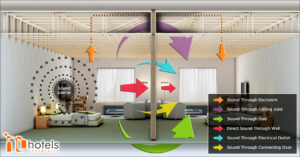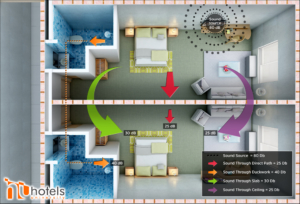How to keep your hotel guestrooms quiet!
Part 4 – What Is Flanking Noise
In the previous three modules, we discussed the following insights:
-
The importance of STC ratings to the success of your hotel design (Link To Part I)
-
The minimum STC standards required by your franchises (Link to Part II)
-
Typical wall/ceiling assemblies and their associated STC rating (Link to Part III)
In today’s featured module, we present information regarding one of the least discussed sound isolation topics and a problem that typically leads to troublesome noise pollution issues related to common wall guestrooms.
Surprisingly, even if the walls between your hotel guestrooms are 100% soundproof, your guests likely will experience unwanted noise from the guest next door. This unwelcome feature of guest experience is the result of flanking noise. Flanking noises are the sounds traveling between rooms via indirect pathways. The sounds have simply found their way “around” the wall assembly.
Sound waves can travel through air pockets between studs and within ductwork and ceiling cavities. They also can travel along various surfaces, including the studs, joists, ducts, pipes, and conduit. In order to understand flanking noise, evaluate the below sketch showing the wall between two hotel rooms:
The red arrow shows the path of direct noise, which passes directly through the wall assembly into the next guestroom. The other colored arrows depict flanking noise, which slips into the next room via pathways unrelated to the wall assembly.
In the graphic below, the wall has an STC of 56, which will typically stop about 55 dB of sound and result in 25 dB passing directly through the wall assembly. Comparatively, flanking noise sources often result in much higher sound transmissions than the 25 dB passing through the wall. In this scenario, noise levels passing through the ductwork and slab are both higher than that allowed through the wall. This means that flanking noise dictates the overall sound transmission, thereby decreasing the overall sound performance between rooms. Unfortunately, in this example, increasing the STC of the wall assembly will do nothing to improve the overall sound isolation between guestrooms.
Below is a list of the most common sources of flanking noise:
-
Connecting/Communicating Doors
-
Electrical Outlets
-
Ductwork
-
Window & Door Jambs
-
Ceiling Can Lighting
-
Demising Wall Caulking





Leave A Comment